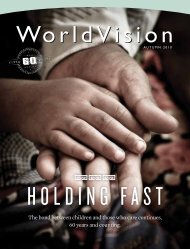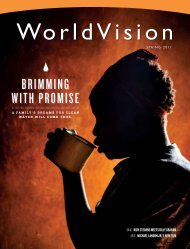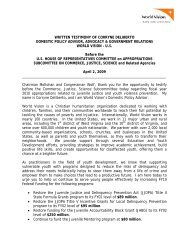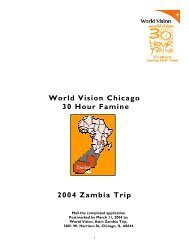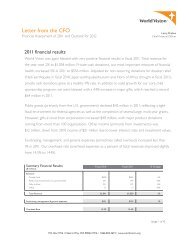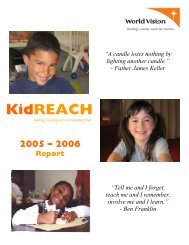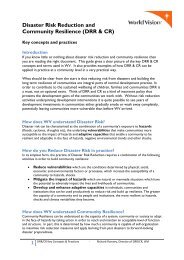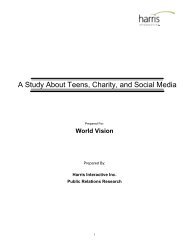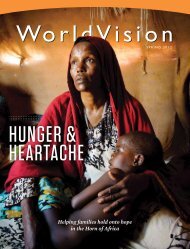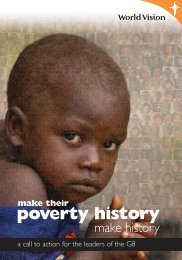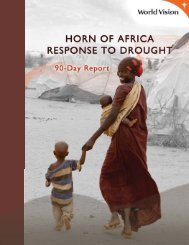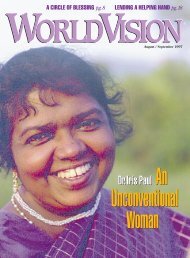World Vision Sri Lanka Tsunami Response
World Vision Sri Lanka Tsunami Response
World Vision Sri Lanka Tsunami Response
Create successful ePaper yourself
Turn your PDF publications into a flip-book with our unique Google optimized e-Paper software.
<strong>World</strong> <strong>Vision</strong> <strong>Sri</strong>i <strong>Lanka</strong> <strong>Tsunami</strong>i <strong>Response</strong><br />
Final Report: December 2004 – December 2007
The 2004 Asia <strong>Tsunami</strong> devastated <strong>Sri</strong> <strong>Lanka</strong>’s coastline, resulting<br />
in over 30,000 deaths and the displacement of thousands of<br />
households.<br />
Communities as far north as Jaffna and as far south as Galle were<br />
left without homes and community infrastructure. Many people fled<br />
from the coastal areas and sought shelter on higher ground in<br />
schools, temples and churches. Economic security for households<br />
was shattered following the disaster, with 90% of working men and<br />
women losing their sources of livelihoods. (Source: ILO <strong>Sri</strong> <strong>Lanka</strong>,<br />
June 2005.)<br />
Many affected areas in the East and the North were also previously<br />
impacted by civil conflict, which exacerbated conditions for<br />
displaced communities in these areas of the country.<br />
<strong>World</strong> <strong>Vision</strong> launched an emergency relief programme in response<br />
to the disaster, followed by a comprehensive recovery program that<br />
has also worked to address the needs of conflict-affected<br />
communities. This Final Report details the response since<br />
December 2004, and its impact on the recovery of targeted<br />
households.
Background<br />
Programme Goal<br />
Pre-tsunami conditions restored and quality of life improved for tsunami-affected communities in Ampara, Batticaloa,<br />
Trincomalee, Colombo, Galle, Hambantota, Kalutara, Matara, Kilinochchi, Mullaitivu and Jaffna.<br />
<strong>World</strong> <strong>Vision</strong> in <strong>Sri</strong> <strong>Lanka</strong><br />
<strong>World</strong> <strong>Vision</strong> was already present in 12 districts in <strong>Sri</strong> <strong>Lanka</strong> (including some fully or partially LTTE controlled areas)<br />
when the tsunami struck and was well-positioned to provide immediate information on the extent of the damage and the<br />
degree of need in affected areas.<br />
The graphic below highlights the geographical areas <strong>World</strong> <strong>Vision</strong> worked in during the response.<br />
The North<br />
Conflict-affected communities in Jaffna, Mullaitivu and<br />
Maritimepattu were devastated by the tsunami disaster.<br />
The lack of elected political bodies, transparent governance, and<br />
the tight control exercised over the area meant that existing sociopolitical<br />
tensions were further exacerbated by the tsunami.<br />
Communities in the North are characterised by continual<br />
displacement, limited access to drinking water and latrines and<br />
high unemployment.<br />
The East<br />
The context of the Eastern districts of Batticaloa, Ampara and<br />
Trincomalee has been one torn between the governance of the<br />
Government of <strong>Sri</strong> <strong>Lanka</strong> and the LTTE. Access to water is also an<br />
issue in this area, with many households traveling long distances<br />
to collect water. Batticaloa district had the greatest asset loss -<br />
71% livestock, 59% productive asset loss and boats at 50%. 1 Civil<br />
society is also a concern in Batticaloa, as is alcohol abuse and<br />
child labour.<br />
The South<br />
The Southern zone remains a minimally conflict-affected area as<br />
intense fighting is contained primarily to the North and East. A<br />
total of 67,572 families were severely affected and displaced in the<br />
costal district of Hambantota, Galle, Kalutara and Matara by the<br />
tsunami. This includes major losses of livelihood capital,<br />
community infrastructure, schools, shops, roads and water and<br />
sanitation infrastructure. People’s access to livelihood<br />
opportunities was severely affected by the tsunami, particularly in<br />
the South where fishing and tourism activities were the major<br />
sources of employment. In Kalutara there was a 73.1% loss of<br />
poultry and livestock after the tsunami. 2 Drug abuse was perceived<br />
to be the highest threat to children in the South zone. 3<br />
1 <strong>World</strong> <strong>Vision</strong> Baseline survey findings, April 2006<br />
2 <strong>World</strong> <strong>Vision</strong> Summary sheet of key findings: Quantitative, March 2006 (Galle)<br />
3 <strong>World</strong> <strong>Vision</strong> Summary sheet of key findings: Quantitative, March 2006 (Galle)
Background<br />
Programme Design and Impact<br />
Baseline Survey<br />
<strong>World</strong> <strong>Vision</strong> conducted a baseline survey to confirm progress indicators and targets, assess the overall socio-economic<br />
situation of tsunami-affected households, assess livelihood objectives, provide recommendations for future and current<br />
programming and determine which communities were more vulnerable to future disasters.<br />
Data collected from the survey indicated the need for multi-sectoral interventions in most districts. In the South,<br />
community needs were generally prioritized as economic recovery in the form of income generating activities, economic<br />
assets and the provision of houses. Social problems such as alcohol and drug abuse and the fear of child abuse were<br />
also identified as being detrimental to recovery and development. In the East, communities prioritized economic<br />
recovery in the form of economic assets, income generation and loans; water and sanitation; shelter; and health<br />
interventions which addressed issues such HIV/AIDS, alcohol abuse, child labour and child rights. Most of these<br />
communities were not only tsunami-affected, but were displaced multiple times over the last 25 years due to the civil<br />
conflict, so the need for peace-building and child protection interventions were crucial. Due to political sensitivities it is<br />
very difficult to gather or receive reliable data from the north. Therefore, in addition to consulting the community, <strong>World</strong><br />
<strong>Vision</strong> collected secondary data from public offices and local organisations. Shelter and income generation were<br />
prioritised in the Northern response.<br />
Final Survey<br />
At the end of the three year programme, <strong>World</strong> <strong>Vision</strong> conducted a quantitative and qualitative study, measuring the<br />
overall impact of the programme from effectiveness to sustainability to appropriateness and relevance. <strong>World</strong> <strong>Vision</strong>’s<br />
goal was to restore and improve the previous living conditions of tsunami-affected communities in nine districts in the<br />
North, East and South zones of <strong>Sri</strong> <strong>Lanka</strong>. The qualitative survey findings were derived from discussions with 971<br />
community members and were measured against three major Transformational Development Indicators: Emergence of<br />
Hope, Caring for Others and Community Participation.<br />
The general findings were that <strong>World</strong> <strong>Vision</strong>’s overarching strategy targeted crucial needs: housing was most often cited<br />
as the most important contribution, followed by livelihood recovery and diversification of income generation<br />
opportunities, greater access to education materials and higher attendance rates in school going children.<br />
Overall, people stated that the programme was essential to building back their community. Major stakeholders<br />
expressed that <strong>World</strong> <strong>Vision</strong>’s programme went to great lengths to demonstrate accountability and coordination.<br />
Coordination<br />
Since the commencement of <strong>World</strong> <strong>Vision</strong>’s tsunami response efforts, assistance has been coordinated at the national,<br />
district and local levels through formal coordination vehicles established by the Center for National Operations (CNO),<br />
Government Agents and UN agencies as well as more informal and informal mechanisms with other agencies and local<br />
bodies. The CNO handed over the operations to another government body know as the Task Force for Reconstruction<br />
and Emergency (TAFREN). United Nations agencies such as UNICEF, UNHCR, WHO, UNFPA and FAO were involved<br />
in coordinating sectoral interventions.<br />
Community Consultations<br />
<strong>World</strong> <strong>Vision</strong> conducted a series of community consultations in nine tsunami-affected districts to inform representative<br />
communities on key results of the baseline survey, seek their validation on <strong>World</strong> <strong>Vision</strong>’s interpretation of the findings<br />
and collect their feedback to help prioritize and target district programmes.
Background<br />
<strong>World</strong> <strong>Vision</strong> committed to a three-year rehabilitation program in <strong>Sri</strong> <strong>Lanka</strong>,<br />
encompassing economic recovery, child protection, infrastructure, shelter, water<br />
and sanitation, health and nutrition, and civil society. Cross-cutting themes such as<br />
environment, gender, conflict sensitivity and disability were also integrated into<br />
project plans.<br />
KEY IMPACT<br />
<strong>World</strong> <strong>Vision</strong>’s response to the<br />
tsunami was swift and<br />
targeted. However, extending<br />
the response past relief<br />
activities into a medium-term<br />
response meant that<br />
communities could come away<br />
from the tragedy stronger than<br />
they met it.<br />
The Relief <strong>Response</strong><br />
Immediately following the tsunami, <strong>World</strong> <strong>Vision</strong> launched a comprehensive relief<br />
response. Food aid was distributed to 120,700 beneficiaries across 10 districts.<br />
More than 640,000 people received non-food relief items such as kitchen utensils,<br />
clothing, hygiene-packs and water. More than 25,000 people received shelter<br />
materials such as tarpaulin and roofing sheets. Temporary classrooms and safe<br />
spaces for children were established. Medical linen and consumables for DNA<br />
identification were donated to hospitals that were inundated with disaster victims.<br />
Sanitation activities were significant during the month following the disaster. <strong>World</strong><br />
<strong>Vision</strong> supported the <strong>Sri</strong> <strong>Lanka</strong>n government by providing 150MT of urgently<br />
needed aluminium sulphate to purify the district of Colombo’s water for a month.<br />
Debris clearance programmes were also initiated to start clearing land for access<br />
and reconstruction efforts.<br />
“I think the best achievement is that we were able to touch people’s hearts. In the<br />
different sectors, we were able to do a lot. We served children through the<br />
children’s programme, we improved people’s livelihood through the economic<br />
recovery programme, and we provided homes to the homeless, and rebuilt<br />
schools through our construction programme. The feedback we get from<br />
communities is that our programming is holistic. They say that they have<br />
experienced a positive change in their lives because of our work.”<br />
<strong>World</strong> <strong>Vision</strong> Staff, Infrastructure<br />
“<strong>World</strong> <strong>Vision</strong> is an organization that serves people and treats everyone equally. It<br />
does not discriminate and that means a lot to us.”<br />
Aid recipient from Ampara, <strong>Sri</strong> <strong>Lanka</strong>
Livelihood Support<br />
Household ability to generate income was severely affected by the tsunami.<br />
Fishermen were without boats and fishing gear, small business owners lost their<br />
shops and merchandise, while inland farmers saw their paddy fields, vegetable<br />
farms, and homesteads washed away.<br />
Business owners suffered significant loss and found it difficult to start over: many<br />
shop keepers who used to operate in the area now known as the buffer zone, were<br />
unable to return and have had to look for new forms of income generation. The<br />
large death toll – more than 30,000 people - called upon young adults and women<br />
to take on new roles as supplementary income generators and in some cases as<br />
the primary income earner.<br />
KEY IMPACT<br />
Increased household resilience<br />
for tsunami affected households<br />
and restored capacity for<br />
economic development within<br />
tsunami-affected communities.<br />
Sector Goal<br />
Target communities recover from disaster and transform into sustainable, vibrant<br />
local economies.<br />
16,919 fishing boats were damaged or destroyed, representing approximately<br />
75 percent of the total fishing fleet. (Source: Ministry of Fisheries and<br />
Aquaculture; FAO <strong>Sri</strong> <strong>Lanka</strong>.)<br />
Activities<br />
<strong>World</strong> <strong>Vision</strong> set to work showing people how they could help themselves. More<br />
than 16,000 people participated in cash-for-work activities, including planting<br />
mangroves and clearing debris from beaches, jungles, rice paddy fields and<br />
irrigation canals. Approximately 35,000 people received natural and productive<br />
asset grants (chickens, goats, seedlings and fruit trees) across the country.<br />
Livelihood trainings were held for more than 12,000 people, enabling some of the<br />
most vulnerable groups - women, widows and the differently-abled – to discover<br />
and diversify their income earning potential through dress making, home<br />
gardening, fish processing and animal husbandry.<br />
Trainings in business management and bookkeeping skills were conducted for 124<br />
community based organisations (CBOs), savings clubs and small business owners.<br />
Community members running an ice making factory, a paddy seed processing<br />
plant and managing savings clubs were among the beneficiaries.<br />
More than 24,000 bicycles were donated in recognition that transportation assists<br />
with income generation, increases attendance in school age children and can<br />
promote better engagement between government civil servants and the<br />
community.<br />
“My father works as a fisherman and now my mother has a small shop; it was<br />
opened after the tsunami.” Boy
Livelihood Support<br />
Evaluation Findings<br />
• New business opportunities for women have resulted in more family income<br />
than before the tsunami.<br />
• Asset ownership varies with the type of asset; women tend to manage liquid<br />
assets like cash and small livestock, whereas larger assets are either held by<br />
men, or jointly held between men and women.<br />
KEY IMPACT<br />
Economic security has<br />
significantly recovered but not to<br />
the point of pre-tsunami levels for<br />
all households or geographic<br />
areas.<br />
• In their spare time, fishermen earn extra income by cultivating home garden<br />
and farm plots.<br />
• Incomes in the South are now higher than pre-tsunami levels, whereas in the<br />
East incomes have dropped 25% lower than pre-tsunami levels.<br />
• Income earning opportunities in fishing and agriculture were significantly<br />
disrupted by the tsunami. As a result, approximately one-third of wage earners<br />
are doing a different type of work than before the tsunami.<br />
• Asset recovery greatly assists people with their ability to earn income. <strong>World</strong><br />
<strong>Vision</strong> concentrated on prioritising the replacement of basic tools and<br />
equipment for fisherman, tradesman, small entrepreneurs, and farmers.<br />
• Country-wide the proportion of people reporting no source of livelihood has<br />
dropped from 9% in the baseline survey to 3% at end of program, however<br />
many of the newly acquired jobs are in wage labour (ie construction).<br />
Back on track with bicycles<br />
In most rural <strong>Sri</strong> <strong>Lanka</strong>n villages, people travel substantial distances to access<br />
essential services such as hospitals, schools, markets and banks. Public bus<br />
services are not regularly available and trishaws are often too costly to hire. “I had<br />
a bicycle before the tsunami,” said Mr. Thirimadara, a recipient of a bicycle from<br />
<strong>World</strong> Bicycle Relief. “I found it in the wreckage when I was clearing a spot to<br />
rebuild my house. It looked like a twisted knot of rust.”<br />
KEY IMPACT<br />
Transportation is cited as an<br />
important component for<br />
livelihood activities. <strong>World</strong> Bicycle<br />
Relief donated 24, 000 bicycles to<br />
assist small business people, civil<br />
servants and school children to<br />
once again be able travel to<br />
markets, commute to and from<br />
work and attend school.<br />
Mr. Thirimadara has two daughters – thirteen and fourteen years old. “My bicycle<br />
saves me $1,600 Rupees (USD<br />
$16) per month on transportation<br />
to and from school,” he said. “I<br />
carry one daughter in the front<br />
and the other on the back<br />
because two kilometers is too far<br />
for the girls to walk.” As his<br />
daughters grow older, Mr.<br />
Thirimadara plans to buy them a<br />
bicycle to share. “My shop has<br />
been running successfully for two<br />
years now. My wife and I have<br />
agreed it is time to let our<br />
daughters travel to school on their<br />
own bicycle.”<br />
Assuming every hour saved could be put into other productive activities (such<br />
as weeding a field, selling fish, visiting clients), bicycle owners in the East are<br />
saving 82 rupees per day, or US$.75.<br />
(Source: Tango International; Impact of Bicycle Distribution on <strong>Tsunami</strong> Recovery in <strong>Sri</strong> <strong>Lanka</strong>.)
Child Protection<br />
Immediately after the tsunami, <strong>World</strong> <strong>Vision</strong> recognised the need to promote and<br />
encourage communities to provide a protective environment to keep children safe<br />
from abuse, exploitation, and violence.<br />
While children struggled to cope after witnessing the loss of so many lives, many<br />
worried how their unemployed parents were going to pay for new school uniforms,<br />
provide safe housing and afford enough food for all members of the family. It was<br />
crucial to build up a sense of routine and stability for children to better enable them<br />
to adjust to new communities, schools and changed family dynamics. In conflictaffected<br />
areas of <strong>Sri</strong> <strong>Lanka</strong>, children’s right to access education, water, and shelter<br />
continues to be compromised on a chronic and regular basis.<br />
Sector Goal<br />
Children affected by the tsunami are able to live in an environment in which they<br />
are protected and their rights are respected.<br />
Activities<br />
<strong>World</strong> <strong>Vision</strong> set up 102 Child Friendly Spaces and 119 Child Societies for more<br />
than 8,000 children to come together, meet and grow. Through regular child<br />
gatherings, <strong>World</strong> <strong>Vision</strong> was able to identify and assist over 3,000 vulnerable<br />
children – including some who were disabled, abused, sexually exploited or who<br />
had dropped out of school. Nearly 20,000 teachers and students participated in<br />
awareness sessions covering topics such as child rights, children’s health and<br />
hygiene and child exploitation. The programme launched 117 activities lobbying<br />
and advocating for the empowerment of girls, the need to address school dropout<br />
trends, prevention of child abuse and carried out peace building activities in<br />
conflict-affected areas.<br />
KEY IMPACT<br />
Children and self esteem: children<br />
were able to describe their own<br />
positive personal skills, traits, and<br />
qualities, and they express<br />
confidence in their ability to<br />
achieve their goals.<br />
Creating safe places for children through the establishment of Child Friendly<br />
Spaces was an important element in providing children with the opportunity to<br />
address psycho-social needs, further education, and broaden development<br />
opportunities. <strong>World</strong> <strong>Vision</strong> trained staff and volunteers to supervise children<br />
spending time in reading corners, libraries and homework areas situated in Child<br />
Friendly Spaces. Educational and recreational supplies and materials were also<br />
provided.
Child Protection<br />
KEY IMPACT<br />
Children attending school view<br />
education as an opportunity to<br />
become better citizens, improve<br />
employment opportunities and<br />
make new friends.<br />
Evaluation Findings<br />
• Children have more opportunities to go to school and to play together, as these<br />
were issues promoted by NGOs.<br />
• Community members credited <strong>World</strong> <strong>Vision</strong> with providing better access to<br />
education for children through provision of books, uniforms, tuition classes and<br />
other assistance.<br />
• If there is not enough money to send all children to school, the decision about<br />
who will study is typically based on academic performance, though in some<br />
families the son will be chosen so he can earn a better living.<br />
• Children describe higher interest in school now that access is possible.<br />
• Approximately 8 out of 10 adults know that the government has laws protecting<br />
children from physical abuse, economic exploitation and harmful advertising.<br />
• The risks that have increased for children after the tsunami are primarily<br />
related to the conflict situation.<br />
• Children’s clubs helped children through their grief after the tsunami.<br />
“I love coming to the Child Friendly Space because I have a chance to be a part<br />
of things I could not do on my own… I get to play with my friends and work on<br />
my drawing and sketching. I want to be an artist when I grow up so that I can<br />
show people what is in my heart and in my thoughts.” Indika Perera<br />
KEY IMPACT<br />
Commonly cited sources of<br />
protection for children at the<br />
community level include not<br />
only parents and relatives but<br />
also teachers, police,<br />
neighbours, human rights<br />
organisations and local NGOs.<br />
Threats to teenagers<br />
In the End of Programme (EOP) evaluation, three commonly perceived threats to<br />
children were identified by communities: drug abuse, child labour, and armed<br />
conflict. At the time of the baseline survey – the first survey conducted by <strong>World</strong><br />
<strong>Vision</strong> - respondents stated that drug abuse was the main threat to teenagers in all<br />
regions across the country. Over a third of households in the East now perceive<br />
child labour as a significant threat to teenagers and approximately a quarter of<br />
households in the South perceive drug abuse as a threat to youth. The increase in<br />
perceived threats is likely due to the social and economic upheaval that has<br />
severely constrained job opportunities and income earning among households<br />
affected by the tsunami. The threat of armed conflict was isolated to conflictaffected<br />
areas and was almost non-existent in the communities in the South.
Infrastructure<br />
Libraries, schools, community halls and sports complexes accounted for an<br />
enormous share of the rubble left behind after the tsunami. Consequently,<br />
infrastructure that survived the tsunami suffered its own wave of damage when<br />
buildings were overtaxed with the responsibility of supporting thousands of<br />
internally displaced people. Hundreds of schools and community halls hosted<br />
displaced persons seeking refuge whist waiting for temporary shelters to be<br />
erected.<br />
Sector Goal<br />
Public facilities damaged [directly or indirectly] by the tsunami are restored for<br />
community use.<br />
More than 60,000 wells were contaminated or destroyed. (Source: <strong>World</strong><br />
Bank/Asian Development Bank/Japan Bank of International Cooperation, Joint<br />
Needs Assessment.)<br />
Activities<br />
<strong>World</strong> <strong>Vision</strong> built 56 schools and 27 pre-schools with adjoining playgrounds and<br />
equipment. For the first time, many students are studying chemistry and biology in<br />
science labs, learning to dance in dance halls, and accessing improved water and<br />
sanitation facilities. More than 3,500 toilets were built in homes and schools,<br />
improving hygiene and sanitation management in all districts across the country.<br />
Key Impact<br />
Repairing and replacing basic<br />
infrastructure such as schools<br />
and health clinics has increased<br />
community access to essential<br />
services.<br />
<strong>World</strong> <strong>Vision</strong> has also completed 18 general health clinics, including two<br />
specialized chest clinics; two vocational training centers, one replacing a previously<br />
existing training centre for differently-abled persons; a sports complex; a net<br />
mending hall; and numerous fisherman rest houses.<br />
In-land school rebuilt after hosting wave of refugees<br />
Tucked inland, approximately 3 km from the sea, <strong>Sri</strong> Devananada Maha Vidyalaya<br />
School in Hambantota is primarily attended by children of paddy seed farmers and<br />
vegetable gardeners. When the tsunami struck, many children’s parents were<br />
selling vegetables at the weekly market near the sea and lost their lives. For<br />
weeks, <strong>Sri</strong> Devananada School turned into a camp for internally displaced people,<br />
hosting nearly 3,000 individuals.<br />
After hosting thousands of refugees, the state of the school worsened. Hema<br />
Sangeewani, (16) was thirteen when the tsunami struck; she recalls that: “Our<br />
former classrooms had holes in the floor and not enough room for all the students.”<br />
Now <strong>Sri</strong> Devananada School has an additional double story building with eight new<br />
classrooms and an administrative building - the first of its kind for the principal and<br />
school staff. “In times of tragedy and sadness the children came together to host<br />
complete strangers,” said school Principal, Mr. Abeyshinge. “The chain of giving<br />
was started by these children and now they themselves are feeling the effects.”
Infrastructure<br />
Light up the world: solar lighting shines in rural <strong>Sri</strong> <strong>Lanka</strong><br />
Thousands of families displaced by the tsunami have benefited from the installation<br />
1,234 solar light systems. Rising inflation rates<br />
have dramatically raised the cost of kerosene,<br />
making basic lighting a rare luxury for people<br />
living in remote areas. Solar lighting provides<br />
an environmentally safe and inexpensive form<br />
of protection for adults and children.<br />
Key Impact<br />
These children in Eastern <strong>Sri</strong><br />
<strong>Lanka</strong> no longer have to walk<br />
19 km to fetch kerosene to do<br />
their homework.<br />
In Jaffna, <strong>World</strong> <strong>Vision</strong> built fishermen restrooms<br />
fitted with solar lights for fisherman who<br />
have had to relocate far from the sea. Solar<br />
lighting is especially useful for fishermen who<br />
set out to sea in early morning darkness and<br />
return late at night with their catch. <strong>World</strong><br />
<strong>Vision</strong> has also installed lights in permanent<br />
homes including those built in an isolated<br />
corner of north western Kilinochchi, providing<br />
children in that area with lighting for the first<br />
time.<br />
“Ever since the tsunami we had no electricity and we had to struggle to find<br />
money to buy kerosene oil, which is very expensive. But now we have this<br />
new light. It is free of charge and does not give out heat.” Sarammashe<br />
Salt water exclusion gates and irrigation canals restored<br />
In the southern district of Galle, <strong>World</strong> <strong>Vision</strong> dredged and cleaned two lakes and<br />
20 km of fresh water canals used to irrigate 43,000 square acres of land by more<br />
than 2,500 farmers. Debris, gravel, and fallen trees were removed from the lakes;<br />
broken bridges were repaired, and culverts were cleaned and rebuilt. At the mouth<br />
of the canal where the fresh water meets the sea, <strong>World</strong> <strong>Vision</strong> replaced two salt<br />
water exclusion gates to filter salt water from the canal. The work promoted<br />
community solidarity as it involved the mobilization of farmers’ associations.<br />
Dickwella Vocational Training Center<br />
<strong>World</strong> <strong>Vision</strong> focused on rebuilding social infrastructure to help bring together new<br />
and old communities. Children, youths, and adults now benefit from the Dickwella<br />
Vocational Training Centre.<br />
“The training centre is important to the community because we don’t have a<br />
public or private space to rent for trainings. Most times we have to travel to a<br />
hotel. Rural people, especially women, don’t like to be seen at hotels and are<br />
therefore often excluded. If you look at the register, half the names are<br />
women. That is a big success.” Liyanagamage Nandadase, Manager of<br />
Dickwella Vocational Training Centre
Shelter<br />
After the widespread destruction caused by the tsunami, shelter was sited as one<br />
of the most crucial areas of need. However, building and repairing homes, grating<br />
new roads, and setting up basic amenities such as electricity and piped water<br />
proved to be a more challenging undertaking than initially thought. Increased costs<br />
of building materials and associated labour, lack of available contractors and a<br />
fluctuating buffer zone delayed the overall building process, nation-wide. The<br />
situation was further complicated in the East and North when an escalation in<br />
fighting forced builders and civilians to flee their homes.<br />
Sector Goal<br />
Improve living conditions for tsunami-affected families.<br />
65,275 houses were completely damaged and 38,561 houses partially damaged but are<br />
still habitable. (Source: TAFREN, November 2005.)<br />
KEY IMPACT<br />
Less than 5% of the study<br />
population is living in<br />
temporary centers or with<br />
friends and relatives and very<br />
few are renting.<br />
Activities<br />
Across tsunami-affected regions, 2,036 homes were built and 1,204 repaired.<br />
Understanding that each community has different needs and faces different challenges<br />
meant that it was necessary for <strong>World</strong> <strong>Vision</strong> to vary its approach to home building. In<br />
places where entire communities had to relocate and rebuild on Government donated<br />
land, <strong>World</strong> <strong>Vision</strong> used contractors to clear the land, build new roads, install electrical<br />
facilities and develop water management systems. On privately owned land, <strong>World</strong> <strong>Vision</strong><br />
initiated a variety of home-owner driven housing projects where beneficiaries were in<br />
charge of building their own homes, managing contractors and meeting deadlines.<br />
Evaluation Findings<br />
• High-quality, well-managed projects were praised in all three zones.<br />
• <strong>Response</strong> efforts by <strong>World</strong> <strong>Vision</strong> aligned well with community-described<br />
needs.<br />
KEY IMPACT<br />
People consider the building of<br />
houses to be <strong>World</strong> <strong>Vision</strong>’s<br />
most important contribution to<br />
communities.<br />
• Most families who lived in their own houses before the tsunami are living in<br />
their own houses now. Some of the families who were sharing houses and<br />
a few families who were living in rented houses have also received their<br />
own homes.<br />
• Communities demonstrated they understood <strong>World</strong> <strong>Vision</strong>’s selection<br />
criteria by stating the following:<br />
- recipients were selected by level of damage to their house<br />
(with fully damaged houses taking highest priority)<br />
- proven ownership of damaged house<br />
- proximity to the buffer zone (30 meters from the sea)<br />
- vulnerable families – lower income families, families with<br />
higher numbers of children
Water and Sanitation<br />
Coastlines battered by the tsunami lost access to major water sources and<br />
sanitation systems, negatively impacting health and well-being and drastically<br />
decreasing access to safe drinking water. Water supply systems and infrastructure<br />
were largely damaged and rendered unusable. Household toilets and sewer<br />
systems also suffered significant damage.<br />
KEY IMPACT<br />
In the baseline survey, onethird<br />
of all households in the<br />
east were using the bush/field<br />
for personal sanitation; the<br />
construction of water and<br />
sanitation facilities reduced<br />
the number to seven percent.<br />
Sector Goal<br />
Persons affected by the tsunami have access to and utilize appropriate and<br />
environmentally acceptable water and sanitation facilities in order to protect the<br />
health and hygiene of targeted communities.<br />
.<br />
Activities<br />
Immediately after the disaster, it was crucial to provide clean drinking water and<br />
sanitation facilities for thousands of people taking refuge in camps for the internally<br />
displaced. In collaboration with the International Organisation for Migration (IOM),<br />
<strong>World</strong> <strong>Vision</strong> provided people with toilets, wells, bathing facilities, drainage systems<br />
and hygiene promotion awareness training.<br />
<strong>World</strong> <strong>Vision</strong> dug 926 wells, subsidized the drilling of 293 deep bore holes, and<br />
provided the National Water Board with drilling and water testing equipment to<br />
restore water testing and maintenance services to more than 35,000 people. In<br />
Hambantota, <strong>World</strong> <strong>Vision</strong> repaired and upgraded the Kirinda Bundala Water<br />
Supply Scheme, providing 5,348 households with new water connections. Across<br />
the nation, more than 3,500 household toilets were built.<br />
"<strong>World</strong> <strong>Vision</strong> put in a water system with toilets and basins - this is very important<br />
as the students use the water facilities for drinking, washing their hands, their<br />
plates and cups."<br />
School Principal, Ampara<br />
Evaluation Findings<br />
• A significant decrease in the proportion of households traveling more than<br />
1 km to a water source in the South.<br />
• Communities in the East report that reliance on tanker water has been<br />
replaced by borehole and piped water.<br />
• Increase of households in the South with access to piped water.<br />
• Households concerned about solid waste disposal, specifically wet<br />
garbage, were introduced to compost procedures.
Health and Nutrition<br />
Following the tsunami, the ability to provide essential health care services was<br />
severely limited. A number of health personnel were injured or lost their lives; many<br />
clinics were damaged or completely destroyed; and regular public services such as<br />
electricity and running water were disrupted, making it difficult to provide the most<br />
basic forms of health care. Fears of disease outbreak were quickly quelled due to<br />
the rapid delivery of medical supplies, equipment and long-standing investment in<br />
the health sector overall.<br />
KEY IMPACT<br />
Adult cooking classes<br />
diversified diets and provided<br />
families with information about<br />
essential dietary needs.<br />
Sector Goal<br />
To alleviate the immediate health crisis at hand and assist with the restoration of<br />
lost capacity. After the relief phase, development activities took place to increase<br />
the capacity of health professionals and health facilities. Awareness sessions on<br />
nutrition, health and hygiene and HIV/AIDS in addition to school feeding<br />
programmes created an opportunity for growth, change, and improved access to<br />
information among tsunami-affected populations.<br />
Activities<br />
<strong>World</strong> <strong>Vision</strong> provided more than 700 facilities with medical equipment, supplies<br />
and medicines. Visits from doctors were coordinated within camps for the internally<br />
displaced. Supplementary feeding programmes assisted more than 2,000 pregnant<br />
and lactating mothers and some 10,000 children under the age of five. A separate<br />
feeding programme for school going children provided a hot lunch for 26,000<br />
students per month. Approximately 900 children were de-wormed and provided<br />
with micro-nutrient supplements.<br />
KEY IMPACT<br />
Home gardens provided<br />
families with a means to<br />
supplement household food<br />
whilst meeting nutritional<br />
requirements.<br />
More than 25,000 people attended awareness sessions on personal and oral<br />
hygiene and HIV/AIDS and STD prevention, including targeted high risk groups.<br />
<strong>World</strong> <strong>Vision</strong> also provided 1,000 families with the opportunity to diversify their diet<br />
and boost nutrient intake through home garden development.<br />
Evaluation Findings<br />
• Increased level of awareness of vector-borne diseases such as dengue<br />
and malaria, including prevention and treatment methods.<br />
• Majority of males and females reporting healthy hand washing behavior –<br />
before and after eating and using the toilet.<br />
• Increased awareness that HIV can be contracted through sexual<br />
intercourse, sharing needles or unclean medical equipment and blood<br />
transfusions.<br />
• Home gardens provided families with the opportunity to practice nutritional<br />
awareness teachings whilst providing further food security, diversity and<br />
high nutritional value food.
Health and Nutrition<br />
KEY IMPACT<br />
Long term food security<br />
increased. Fewer people report<br />
extreme coping behaviors such as<br />
skipping meals for days at a time,<br />
buying food on credit, and<br />
sending household members to<br />
eat elsewhere.<br />
Mobile Blood Bank in Jaffna<br />
The Jaffna Teaching Hospital in Northern <strong>Sri</strong> <strong>Lanka</strong> continues to coordinate regular<br />
blood donation drives through out the Peninsula since receiving a mobile blood<br />
clinic. The mobile clinic travels to schools and community centres, drawing blood<br />
and educating communities about the on-going need to give blood. The<br />
administration team running the clinic is enthusiastic about the reception the clinic<br />
gets when it travels, saying that people are more likely to donate when the clinic<br />
comes directly to their community. The hospital staff emphasized the importance of<br />
having a mobile blood bank during emergencies – be they natural disasters or manmade<br />
– and said the blood has saved countless lives.<br />
K EY IMPACT<br />
In the East, 18% of households<br />
are utilizing loans for food<br />
purchase compared to 5% in the<br />
South – an 80% increase in the<br />
East and a 10% drop in the South<br />
since the baseline survey.<br />
“Since this school feeding activity started we’ve been getting good food<br />
regularly and on time. In my class, half of the students used to come to<br />
school without their breakfast. Now they are very happy and active in their<br />
studies.” 9 year-old Panarajah<br />
KEY IMPACT<br />
At its peak, <strong>World</strong> <strong>Vision</strong>’s<br />
supplementary feeding<br />
programme assisted more<br />
than 10,000 children under the<br />
age of five.<br />
School Feeding Programme<br />
Children affected by the tsunami and displaced by conflict immediately became<br />
more vulnerable due to lack of food security. Without food, children cannot perform<br />
their best; they cannot concentrate on their studies and are often pressured to work<br />
at an early age to provide for their family. In partnership with the <strong>World</strong> Food<br />
Programme (WFP), <strong>World</strong> <strong>Vision</strong>’s hot lunch<br />
programme provided a platform to address<br />
long-term health and nutrition issues, gave<br />
children a reason to come to school and<br />
provided them with the energy and<br />
nourishment to think, play, and grow. On<br />
average, <strong>World</strong> <strong>Vision</strong> fed 26,000 children per<br />
month – alleviating the financial burden<br />
imposed on unemployed parents, immediately<br />
following the tsunami. The school feeding<br />
programme became an important way of<br />
keeping school attendance rates high and<br />
allotting parents’ time to find new ways of<br />
generating income. <strong>World</strong> <strong>Vision</strong> also<br />
assisted pregnant and lactating mothers and<br />
children under the age of five through a<br />
separate supplementary feeding programme.
Civil Society<br />
Aid agencies are united in their ambition to save lives and reduce suffering but the<br />
quality and effectiveness of their response can be compromised if the community is<br />
not consulted and involved with programming. To raise the standard of<br />
accountability within the tsunami response, <strong>World</strong> <strong>Vision</strong> formed a special team<br />
called the Humanitarian Accountability Team (HAT), which focused solely on<br />
community engagement and interaction. Regular meetings, negotiations, and<br />
consultations between HAT and the communities <strong>World</strong> <strong>Vision</strong> served, enabled all<br />
stakeholders involved to establish realistic goals and to agree upon expectations.<br />
KEY IMPACT<br />
Community notice boards,<br />
consultations and regular<br />
meetings generated greater<br />
transparency and awareness<br />
about <strong>World</strong> <strong>Vision</strong>’s<br />
programme.<br />
Sector Goal<br />
Foster and promote community sustainability by integrating accountability to<br />
stakeholders.<br />
Activities<br />
The Humanitarian Accountability Team (HAT) facilitated over 600 community<br />
consultations, regarding beneficiary selection and verification processes, designs<br />
for construction based projects such as homes, toilets, and add on kitchens, and<br />
ways in which the community could monitor and evaluate the projects. The HAT<br />
team also set up community notice boards in shelter sites, providing a way for<br />
people to notify one another of community functions, emphasize agreed upon<br />
community behaviour rules and for <strong>World</strong> <strong>Vision</strong> to communicate its projects goals,<br />
budgets and end dates.<br />
Evaluation Results<br />
• Community involved at each stage of shelter building with full authority and<br />
responsibility for monitoring.<br />
KEY IMPACT<br />
<strong>World</strong> <strong>Vision</strong> advocated for just<br />
shelter policies, ensuring joint<br />
titling of deeds for men and<br />
women.<br />
• Shelter planning meetings held by <strong>World</strong> <strong>Vision</strong> during the initial stages of<br />
a project were inclusive of men, women and village leaders.<br />
• Community participation on the design and selection of materials lead to<br />
greater satisfaction from home owners.<br />
• <strong>World</strong> <strong>Vision</strong> trained owners in proper construction techniques so they<br />
could closely supervise the building.<br />
• People considered housing to be the most important contribution, saying it<br />
is difficult to survive without a home and even more difficult to build a home<br />
immediately after disaster strikes and families are left with nothing.
Cross-Cutting Themes<br />
KEY IMPACT<br />
Trust building activities such as<br />
tug-of war helped forge new<br />
friendships amongst Singhalese,<br />
Tamils and Muslims living<br />
together in new housing<br />
communities for the first time.<br />
Peace Building & Conflict Resolution<br />
Local Capacities for Peace (LCP) assessments were conducted in 17 shelter sites<br />
in seven districts in 2006. Recommendations from the assessments included the<br />
following: the need to increase community engagement and participation to<br />
strengthen community structures; to include neighbouring communities; to position<br />
infrastructure/resources in shared locations where possible; and increase<br />
consideration of LCP issues through the project management cycle, including<br />
assessment, design, and implementation and monitoring. Through out the<br />
programme, more than 300 <strong>World</strong> <strong>Vision</strong> staff and community representatives were<br />
trained in (LCP).<br />
A <strong>World</strong> <strong>Vision</strong> staff member describes the discrimination faced by 150<br />
families considered to be ‘low caste’ and how <strong>World</strong> <strong>Vision</strong> was able to<br />
perpetuate lasting change:<br />
“In the Marudapuram Karainagar community [Jaffna] most of the people are<br />
Hindus. They had the freedom to travel only 200 meters around the village.<br />
They cannot even have a bath in the Kovil River as it is located 200 meters<br />
away. Even the school children face the same problem.<br />
We built a beautiful building in their village for them. They conduct extra classes<br />
in the building and also we introduced sport meets and cricket matches in<br />
between neighboring villages. Further they [Marudapuram Karainagar<br />
residents] have build-up a very good relationship with other villagers and they<br />
[neighbouring communities] have good understanding amongst them.<br />
After just one year of time much change was witnessed in the village. There<br />
were changes to the way they dressed and also there was a positive change in<br />
the attitudes and behavior as well. When the time came to bid farewell to the<br />
Marudapuram Karainagar villagers it was a very emotional moment for us but<br />
they had a great hope for the future that showed in their faces.”<br />
Key Impact<br />
Community members in Marvan<br />
Attapaththugama, a new housing<br />
site in the Matara District<br />
successfully negotiated for a<br />
public bus service on a 22 km<br />
stretch of road. More than 200<br />
children no longer have to walk 3<br />
km to school and more than 60<br />
pregnant women can now visit<br />
the hospital on a regular basis.<br />
Advocacy<br />
Advocacy was weaved into all aspects of <strong>World</strong> <strong>Vision</strong>’s work – more than 17<br />
communities were informed of their legal rights and assisted to build and execute<br />
their own advocacy strategies.<br />
Environment<br />
<strong>World</strong> <strong>Vision</strong>’s programme took into account impact on the environment. Envirofriendly<br />
processes such as compost and safe disposal of grey water were<br />
integrated into water and sanitation activities.
Cross-Cutting Themes<br />
KEY IMPACT<br />
Higher levels of community input<br />
and engagement at all stages of<br />
the construction projects gave<br />
way to higher levels of<br />
satisfaction and contentment of<br />
homeowners including the phases<br />
of the process and the houses<br />
themselves.<br />
Disability<br />
<strong>World</strong> <strong>Vision</strong> designed its programming to support the needs of differently-abled<br />
people specifically by through specialized economic recovery programmes and<br />
ensuring new infrastructure such as schools, homes and community halls were<br />
inclusive of hand rails and wheel chair access, where possible.<br />
Murugesh’s new home<br />
When the tsunami struck in December 2004, Murugesh's father was killed and the<br />
family home was destroyed. Since then, the boy's mother, Saraswathi, has<br />
struggled to meet the basic needs of her four children. Now, the family has a home<br />
in a new 40-unit apartment complex <strong>World</strong> <strong>Vision</strong> has built. A ramp leads to<br />
Murugesh's front door. Inside, the bathroom differs from most rural <strong>Sri</strong> <strong>Lanka</strong>n<br />
homes — a commode replaces the typical squat latrine.<br />
"I have the freedom to do a lot more; it means everything to me that we have this<br />
house," said Ms. Saraswathi.<br />
Key Impact<br />
Women are now saving money<br />
which they can borrow in times of<br />
emergencies.<br />
Gender<br />
<strong>World</strong> <strong>Vision</strong> was intentional in involving women as a key partners and recipients of<br />
assistance. Women who have equal opportunity and access to resources and<br />
education can earn more, become positive role models for girls and boys and offer<br />
solutions to community problems.<br />
Savings clubs help women build more secure futures<br />
As part of a larger economic recovery programme, <strong>World</strong> <strong>Vision</strong> encouraged<br />
people to get together and form savings clubs. For some members, the thought of<br />
saving one rupee a day was unbearable. “But we are poor!” was the overall<br />
reaction to saving money.<br />
Chandima Nisansala, 23, learned to make and pack sweets and ‘short eats’ at a<br />
<strong>World</strong> <strong>Vision</strong> skills training course. She now sells the sweets to school children and<br />
small shops near her home. She says she receives continued mentoring from older<br />
women in her savings club who carry out the same occupation. “There are a lot of<br />
things I can’t do on my own that I can do in a group,” she said when asked about<br />
the value of her savings club. “It’s not just about saving money but about investing<br />
time and support for each other,” she continued. <strong>World</strong> <strong>Vision</strong>’s Priyantha<br />
Karaliyadda said, “The clubs are comprised of mostly women because many of the<br />
men work outside of the home. These women have learned how to start their own<br />
business and make it profitable but they have also discovered a new sense of<br />
kinship and support from each other.”
Donors and Expenditure<br />
<strong>World</strong> <strong>Vision</strong> Support Offices<br />
WV Australia<br />
WV Canada<br />
WV China<br />
WV Finland<br />
WV Germany<br />
WV Hong Kong<br />
WV Ireland<br />
WV Korea<br />
WV Malaysia<br />
WV New Zealand<br />
WV Singapore<br />
WV Switzerland<br />
WV Taiwan<br />
WV United Kingdom<br />
FY05 Expenses<br />
$33,447,105<br />
Programme Expenses<br />
(FY: Oct 1st - Sep 30th)<br />
FY06 Expenses<br />
$45,294,811<br />
FY08 Budget<br />
$6,234,275<br />
FY07 Expenses<br />
$29,109,388<br />
Total Expenses<br />
$114,085,579<br />
FY08 Budget<br />
FY07 Expenses<br />
FY06 Expenses<br />
FY05 Expenses<br />
<strong>World</strong> <strong>Vision</strong> in SRI LANKA<br />
• 26 Area Development Programmes<br />
• Working across 12 districts<br />
• Helping more than 60, 000 children<br />
• Serving over 960 communities<br />
"Finally, in viewing all<br />
available information one has<br />
to conclude that <strong>World</strong> <strong>Vision</strong><br />
did an outstanding job of<br />
helping households and<br />
communities recover from the<br />
terrible events of December<br />
2004. It committed itself to<br />
communities for a two-year<br />
period instead of considering<br />
the mission accomplished<br />
after relief efforts were<br />
completed. It forged a tight<br />
bond with the communities<br />
and had staff that was<br />
compassionate and dedicated<br />
to the goals and objectives of<br />
the project. Everybody<br />
associated with this effort<br />
should be proud."<br />
- TANGO INTERNATIONAL.<br />
<strong>World</strong> <strong>Vision</strong> is a Christian relief,<br />
development and advocacy organisation<br />
dedicated to working with children,<br />
families and communities to overcome<br />
poverty and injustice.<br />
Within a complex programmatic context, reasonable efforts have been made to provide accurate descriptions of results in our report.<br />
www.wvasiapacific.org



